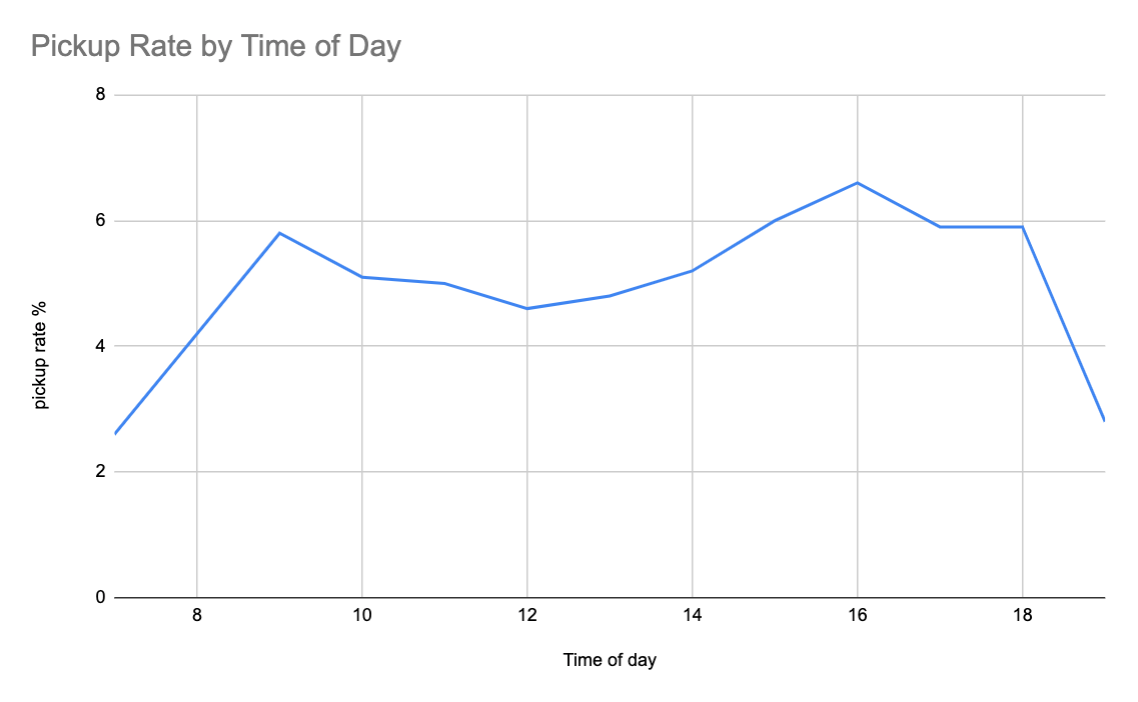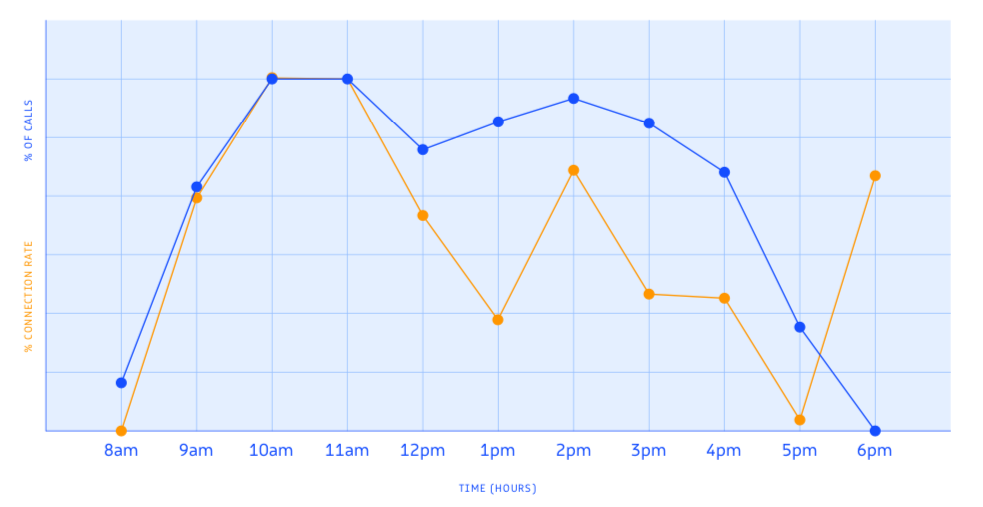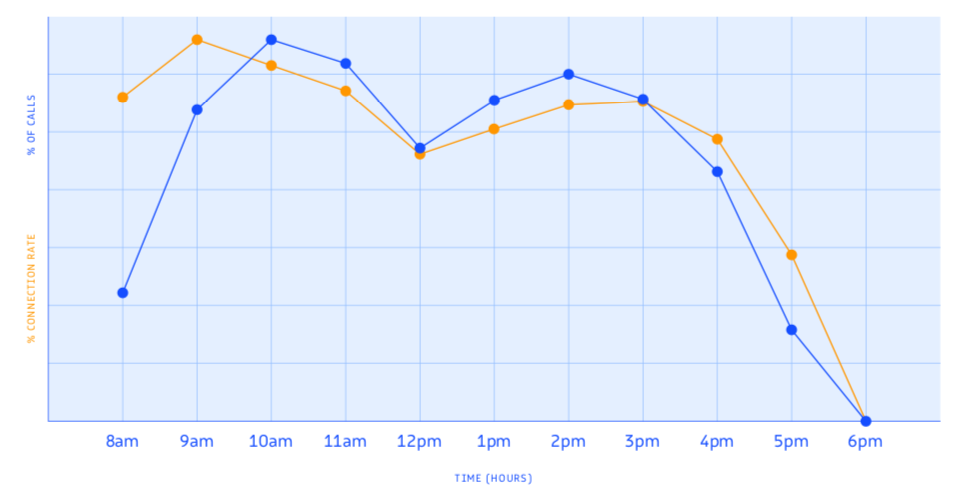The Best Time to Cold Call Prospects in 2025 (Backed by Data)
When is the best time to make sales prospecting cold calls?
To find out, we launched a major study, mining call data from millions of sales calls to uncover which times of day are ideal for key sales activities, including the best time to make cold calls.
Below, we’ll reveal the results of that study. But far more importantly, we have some new findings fresh that just might shake up when you go after your best leads.
Why Knowing Peak Call Connection Times Is Critical for Sales Prospecting
Knowing when prospects are most likely to pick up the phone is critical. Even reps that dial all day long, should always be prioritizing their hottest outbound prospects during times when they are most likely to engage. Sales sequencing technology has made it easier than ever to schedule calls (and other sales outreach like emails and texts) during those key windows.
Experts agree, sales leader research from TOPO (now part of Gartner) reveals that sales leaders are prioritizing live call execution as the most important skill of new sales people. That is a leading indicator of the fact that sales development teams are still seeing cold calling as a valuable channel. The best time to make cold calls is an important part of live call execution, as calling at the right time can maximize your answer rate, thereby maximizing your sales conversations and ultimately opportunities.
What is the best time to call prospects in 2025?
Since we provide the industry’s top sales dialer and sales cadence solutions, our customers often ask us for best practices around outbound prospecting. One of the questions we get asked most frequently is “when should my reps dial their best prospects.” We thought it would be helpful to analyze and surface call data from our own team. After all, what’s true for our own sales team could potentially be true for your team.
We worked with our Senior Director of Revenue Operations Jordan Henderson to look at call connection rates by time over the past 90 days. And the results were incredibly interesting, because as you’ll see below, they don’t line up with the results from our broader 2019 study. This could potentially correlate with a change in behavior among key decision makers.
So what did we find from looking at our own team’s dialer and sequence call data?

It appears that decision makers are more likely to engage in the late afternoon. With peak engagement during the 4-5pm hour. This window is followed closely by the 3-4pm and 5-6pm hours.
So what is the takeaway? Sales teams should consider scheduling outbound calls and sequence actions with top targets during late afternoon windows (3-6 pm in their own time zone).
When we saw these results, we wanted to share them with you right away, since they run counter to our 2019 study. We are still going to share those results with you, since they reflect a larger study across numerous industries. But you should consider, especially if you’re selling SaaS software like we do, experimenting with late afternoon call blitzes to top leads.
Why Prospecting in the Late Afternoon Makes Sense
In B2B Sales it’s crucial to remember that your prospects have a job to do as well. And when they are laser focused on doing that job, they are going to be less likely to pick up their phone to chat with a stranger. In the late afternoon, Slack threads are going quiet, and requests from co-workers are likely dying down. It’s less likely that your prospect will be on a Zoom call. As such, if they are going to pick up their phones at all, this seems like a window when they’ll be open to it.
Is the late afternoon the only good time to connect with prospects? Let’s take a look at our 2019 data to see another potential window for successful cold calling.
Prior Research – When is the best time to cold call?
Our research showed that the best time to call prospects (in their own time zone) was in the late morning.
Cold calling in the morning makes sense for several reasons. Working professionals start their day at varying times, but the majority are in the office by the late morning.
While meetings often get booked during these hours, that means this is the time of day that professionals are expecting to hear from people, which may make them more likely to answer the phone.
Check out this chart for a detailed breakdown:

Keep in mind that this data is for all calls made through the Revenue.io platform in the past – that includes calls made between business professionals who have pre-existing relationships. For most sales reps, a more helpful chart would be to examine cold calls specifically (see our recent research above).
Best time to call based on call data
According to our past call data, the best time to cold call was shown to be 9am in the call recipient’s local time zone.
Call connection rates were highest between 8am-11am in the time zone of the person receiving the call.
That means that sales development reps or anyone making prospecting calls could try structuring their day by prioritizing morning sessions for call blocks with their dialer or sequence tools during these windows.
Check out this chart for a detailed description of when most teams make cold calls and when prospects are picking up the phone, according to our research.

Sales reps shouldn’t necessarily avoid making calls during times of lower connection rates – those lower connection rates are simply times when prospects are less likely to pick up the phone, but that doesn’t mean they will never answer the phone at that time. The idea is simply to prioritize the best prospects for windows in which they are most likely to pick up.
The best time to make prospecting calls based on time zone
The best time to make prospecting calls during the day is whenever your target leads are picking up the phone. This means it is very important to structure your day according to your sales territory’s working hours, and make your calls during their peak connection rates. For example, if you are based on the east coast of the United States but calling in to the west coast, the data shows that you should begin making your prospecting calls at 11am, and continue calling through 6 or 7pm to ensure you are taking full advantage of the times that your prospects are answering the phone.
When is the worst time to call prospects?
The worst time to call prospects is outside of working hours. During these times, not only are connection rates lower, but a phone call is likely to bother your prospects. Calling prospects during their personal time is usually inadvisable.
During working hours, the worst time to call prospects is around 1pm. Depending on their work day, most prospects are spending time eating out with colleagues, taking a break, or getting some much needed focus time during these hours.
This answer rate also coincides with the energy drop-off that research shows is common among working professionals just after lunch. Many of us experience an energy lull during this time, and it makes sense that we are less willing to engage with someone unknown on the phone at this hour.
How can you make data about the best time to call leads actionable?
Now that we have worked through several different ways to think about optimal times to cold call businesses and prospects, what do we do with the information?
Our best advice for sales reps looking to reach more customers consistently is to schedule the day around call blocks, and treat these metrics as benchmarks.
For time blocks, set aside an hour at a time for your prospecting calls, several times throughout the day. If these are just standard call blitzes or steps in a sales cadence, ensure that you have your prospect lists ready to go, with phone numbers, names, and all of the contextual history of their engagement with your company. Then, when the time of your scheduled call block arrives, you are ready to begin dialing through your list and don’t have to waste your time doing prospect research.
Potential Pitfalls
There are many pitfalls that can capture a salesperson’s time, keeping them from spending their focused effort where it matters. If you can keep the discipline of call blocks during peak connection times, you are more likely to reach your customers and generate more opportunities for your pipeline.
Keep in mind that these data points are best used as benchmarks – in other words, they are a helpful starting place for making decisions about how to spend your time. As a part of your sales management process It is extremely important that you begin collecting your own data about peak connection rates, as your specific market and target audience will have nuances and differences from data points generalized across many industries.
Whether you find the best results in the late morning or the afternoon could depend on so many factors. But it’s important to experiment and, most of all, measure results by time of day. The Revenue.io platform makes it easy to track call connection rates by time of day. In fact, we deliver turnkey reports that teams can start using almost instantly.
Cold Calling Phone Tactics
Successful inside sales reps find themselves wearing many hats. During prospecting you take on the role of a private investigator. When sending follow-up emails, you must weigh each word carefully like a poet. But the best sales reps are also much like behavioral psychologists, acquiring data about the way prospects operate and searching for patterns.
 Recently, we cited a study revealing that more key decision makers are willing to pick up the phone for certain types of inside sales calls, creating increased opportunities for reps at B2B companies. But to maximize your chances of adding each prospect to your pipeline, you don’t just need to know who to call – you need to know when to call.
Recently, we cited a study revealing that more key decision makers are willing to pick up the phone for certain types of inside sales calls, creating increased opportunities for reps at B2B companies. But to maximize your chances of adding each prospect to your pipeline, you don’t just need to know who to call – you need to know when to call.
Examining the Data
A basic understanding of how businesses work can offer insights to intuitive B2B sales reps. For example, it makes sense that an executive might be easier to reach directly following standard work hours, after admins have left for happy hour. But as sales teams become increasingly data-driven, intuition alone won’t suffice. For the best results, inside sales teams need to embrace an evidence-based prospecting strategy. Here’s some data that can help you identify key prospecting windows.
An MIT study reveals that:
- 4-6pm is the best time to make contact with a lead (114% higher than the worst time block)
- 8-9am and 4-5pm are the best times to qualify a lead
- Wednesdays and Thursdays are the best days to make contact with a lead (Friday is the worst day)
- Thursday is the best day to contact a lead in order to qualify the lead
- The worst times to contact and qualify leads are during lunch/crunch time (11am-2pm)
Call Blitzing – Even on Holidays
During these call windows, when leads are more likely to be available, we recommend that B2B sales reps go for the gusto and dial as many leads as possible. This is known as a call blitz. The data indicates reps should kick their prospecting into overdrive on Wednesday and Thursday between 8-9am and 4-6pm.
When trying to reach top-level executives, some sales leaders also recommend calling after hours. In an HBR article, Vorsight’s Steve Richard recommended “call blitzing during ‘call windows,’ before 8:30 am and after 5:30 pm when admins are gone.”
Richard also champions call blitzing on holidays. It’s quite common for executives to work during holidays when lower-level staff members are on vacation. Weekends can even be a good time to access executives, as many businesses are moving away from standard corporate hours. This is especially true of companies like software startups and advertising agencies.
Gather Your Own Intelligence
Examining data from MIT or reading thought leadership pieces like Steve Richard’s can help you formulate a more effective prospecting strategy. But at the end of the day, businesses need to gather their own sales intelligence data in order to build an evidence-based strategy. Depending on your industry, you might find that Friday is the most effective day to dial leads. You might also discover that more calls end in opportunities during the early afternoon. The point is that if sales managers aren’t tracking call metrics in a CRM, it’s impossible to truly know when leads are entering the pipeline. Revenue.io gives sales managers real-time visibility into when reps are contacting decision makers, and the outcome of those calls. By closely monitoring call metrics, sales teams can build a prospecting strategy that enables maximum engagement with prospects.
Prospecting and Cold Calling Resources
At Revenue.io, we’ve processed hundreds of millions of sales conversations, and we spend a lot of time optimizing our own team’s sales workflows using data. That means we have spent a lot of time researching and understanding cold calling. This metric is just the tip of the iceberg.
Here is more original research and thought leadership that you can use to take your prospecting game to the next level.
The 2022 Sales Pipeline and Revenue Benchmarks
In addition to getting pipeline and benchmark averages from over 200 companies, we found that there’s a sweet spot for how much pipeline and revenue your sales reps should create (if you go past it you’ll actually create less revenue).
So if you want to start counting sheep instead of pipeline numbers, this is the report you need to put all your sales worries to bed.
The RevOps Team Benchmarks
48% of B2B companies now have a RevOps function. We can practically hear you asking: Is that a lot? Has it changed much from last year? Why and how are all these companies going with RevOps? Is it worth it?
To answer at least a couple of those questions, 48% is a lot! And it’s up 15% from last year. Inside the report, you’ll find answers to all the other questions too (and some interesting findings about what’s actually standing in the way of cross-departmental alignment – but we’ll let those be a surprise).
5 Sequences Every Rep Needs in their Playbook
Gartner predicts that 75% of B2B sales organizations will augment traditional sales playbooks with AI-powered guided selling solutions by 2025.
Because these solutions minimize the guesswork of sales, you can execute the perfect playbook every time. …But what does a perfect playbook look like?
Using the best practices we’ve gained from helping hundreds of customers find success with Guided Selling, our best-in-class sequencing tool, we’ve put together a list of the greatest hits to help you reach your revenue goals.
How to Get a Meeting with Anyone
Check out this masterclass that we did last year with Stu Heinecke. He shows how he got a 100% response rate (yep, you read that right) from a cold outbound prospecting campaign.
